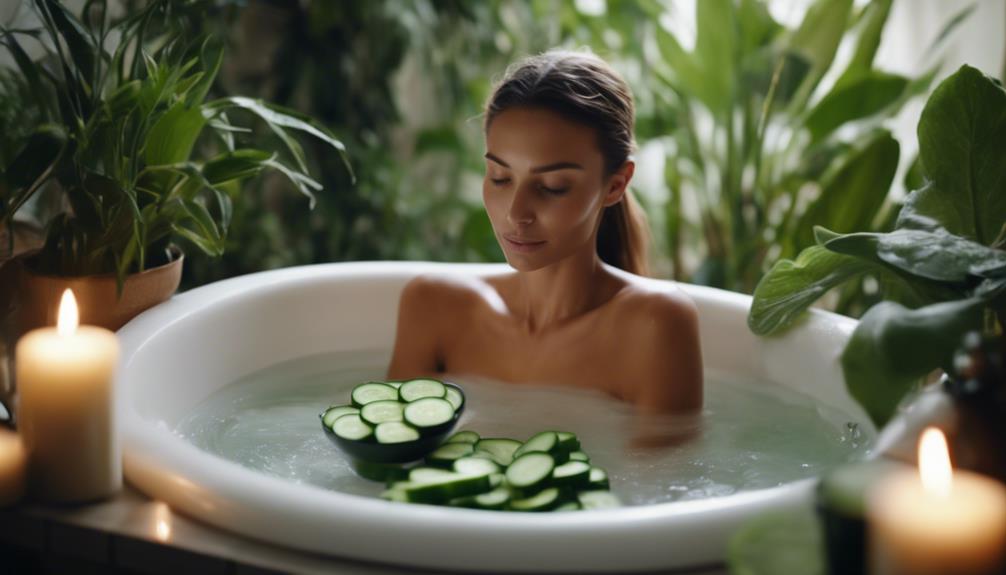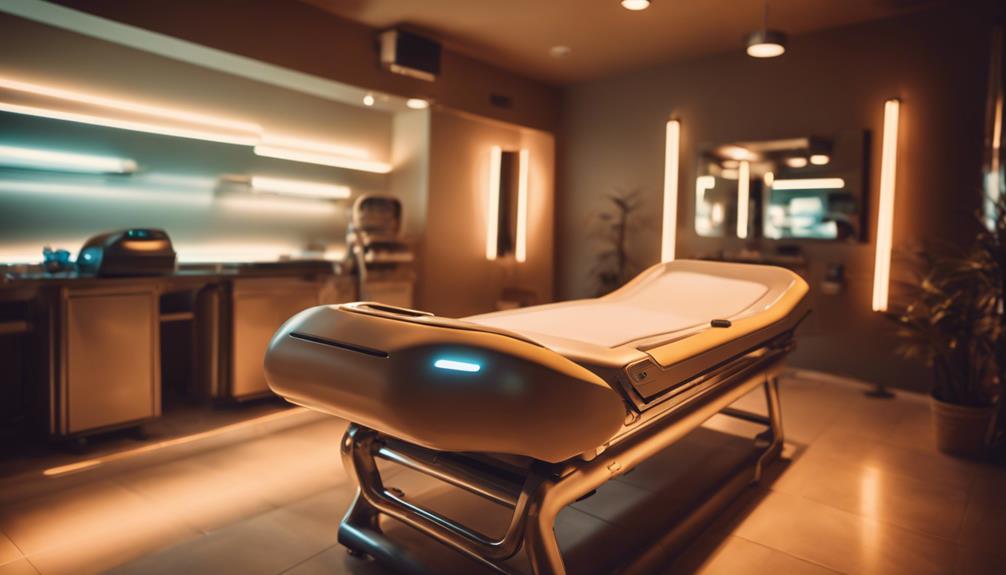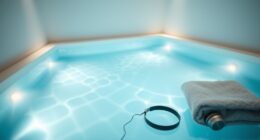To enjoy safe tanning sessions, start by knowing your skin type on the Fitzpatrick Scale. If you have fair skin, begin with shorter sessions and gradually increase the time. Always wait at least 48 hours between sessions to allow your skin to recover and produce melanin. Stay hydrated before and after tanning, and apply moisturizer to maintain skin health. Be vigilant for any signs of discomfort or irritation and take breaks if needed. Following these tips will help you achieve a beautiful tan while minimizing risks. There's plenty more to discover about maximizing your tanning safety and results.
Key Takeaways
- Determine your skin type on the Fitzpatrick Scale to tailor your tanning sessions accordingly.
- Start with shorter tanning sessions, gradually increasing duration as your skin adapts to UV exposure.
- Maintain a minimum of 48 hours between sessions to allow for skin recovery and melanin production.
- Stay well-hydrated before and after tanning, and apply moisturizer to enhance skin resilience and tan longevity.
Understanding Skin Types
When you understand your skin type, you can tailor your tanning approach to maximize results while minimizing the risk of burns.
The Fitzpatrick Scale categorizes skin types from I to VI, helping you identify how your skin reacts to UV exposure. If you have Type I or II skin, you burn easily and should proceed with caution.
Even Type II skin can achieve a tan, but careful management is key. Knowing your skin type helps you make smarter decisions about tanning sessions, ensuring you don't overexpose yourself.
All skin types can benefit from sunbeds, but understanding your unique needs allows you to enjoy a safe and effective tanning experience without the worry of burns or damage.
Customizing Your Tanning Routine
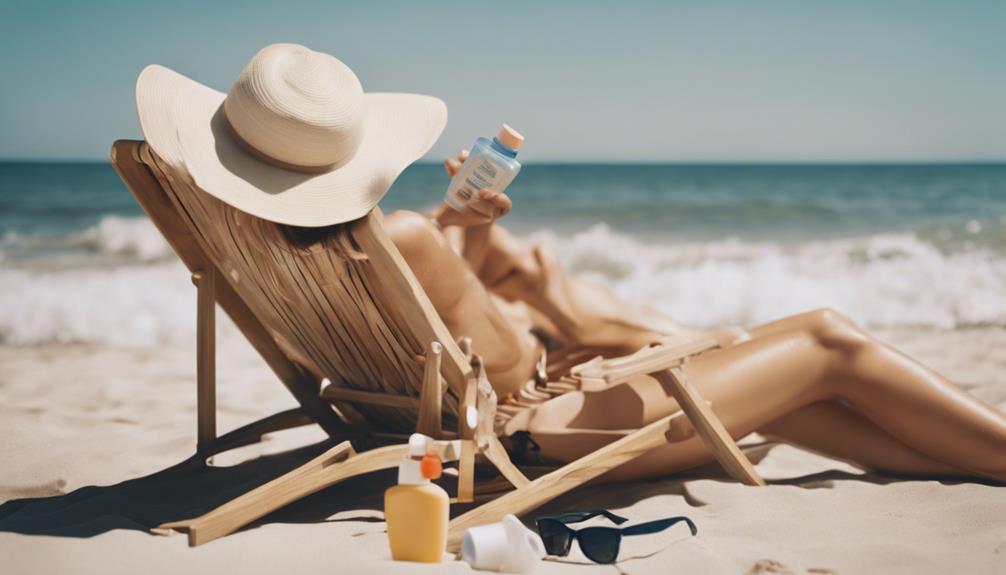
Understanding your skin type sets the foundation for customizing your tanning routine to maximize results while minimizing the risk of burns.
Start with shorter sessions, especially if you have fair skin, to gauge your skin's tolerance to UV exposure. Gradually increase the duration and frequency of your sessions as your skin adapts.
Aim for at least 48 hours between tanning sessions to allow your skin to recover and build melanin safely. Always consult the tanning staff for advice on UV strength and session lengths tailored to your skin type.
Pay close attention to your skin's signals; if you feel discomfort, stop immediately. Customizing your routine helps you achieve that beautiful glow without sacrificing skin health.
Melanin Production Insights

Melanin production plays an essential role in protecting your skin during tanning sessions by absorbing UV rays and enhancing your tan. When UV rays hit your skin, melanocytes kick into action, producing melanin to shield against damage. By understanding your skin's melanin levels, you can tailor your tanning strategy for better results.
| Skin Type | Melanin Production | Recommended Session Duration |
|---|---|---|
| Type I | Low | 5-10 minutes |
| Type II | Moderate | 10-15 minutes |
| Type III | Moderate-High | 15-20 minutes |
| Type IV | High | 20-30 minutes |
Gradual exposure allows for ideal melanin oxidation, ensuring a rich, deep tan while minimizing risks. Always listen to your skin's cues!
Risks of Overexposure
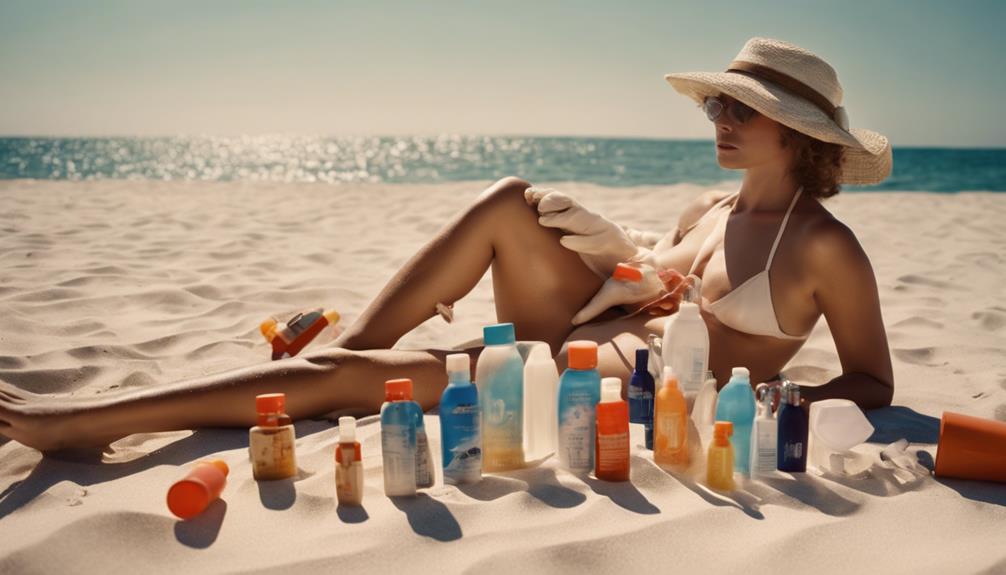
Overexposure to UV rays can greatly increase your risk of skin damage and health issues, making it essential to space out your tanning sessions. Tanning too frequently can lead to burns, premature aging, and even skin cancer.
It's important to listen to your body and recognize any signs of discomfort or irritation. Start with shorter sessions to assess how your skin reacts, and avoid multiple sessions in one day.
Allow at least 48 hours between tanning to give your skin time to recover and build melanin safely. Regular skin checks are critical to monitor any changes.
Importance of Skin Hydration
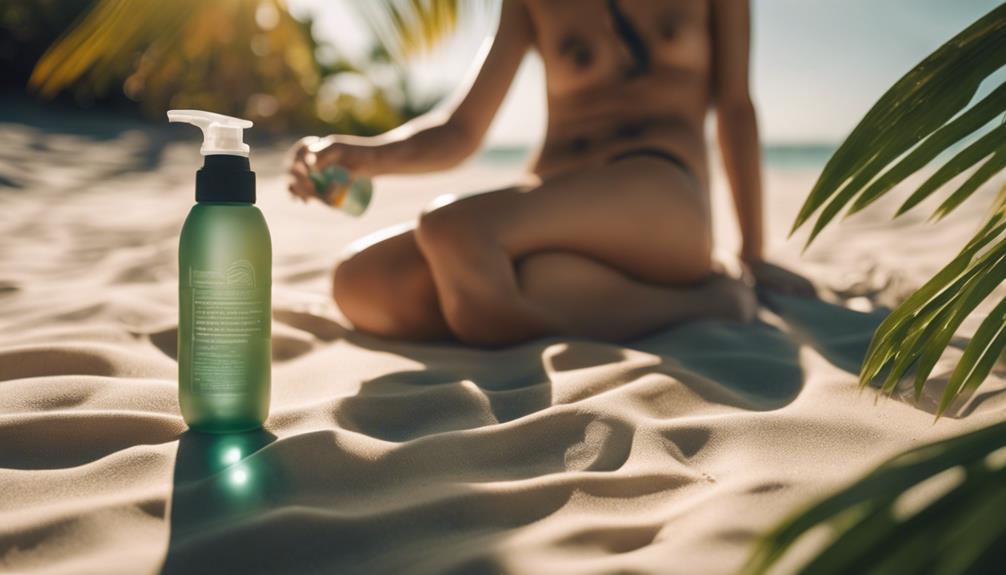
Keeping your skin hydrated is essential for achieving and maintaining a beautiful tan while minimizing the risk of damage. When your skin is well-hydrated, it's more resilient and better able to withstand UV exposure.
Drink plenty of water before and after your tanning sessions to support overall hydration. Additionally, apply a good moisturizer to keep your skin supple and prevent dryness. This not only enhances the tanning process but also helps your tan last longer.
Avoid products with alcohol, as they can strip moisture from your skin. Remember, hydrated skin absorbs UV rays more effectively, giving you that golden glow without the harsh side effects.
Prioritize hydration for ideal tanning results and healthier skin.
Post-Tanning Care Tips

To maintain your gorgeous tan and promote skin health, follow these essential post-tanning care tips. Proper aftercare guarantees your skin stays radiant while minimizing potential damage.
- Moisturize Daily: Use a high-quality moisturizer to keep your skin hydrated, which helps prolong your tan and prevent dryness.
- Avoid Exfoliation: Skip scrubbing or exfoliating for at least a week post-tan, as this can fade your color and irritate your skin.
- Stay Hydrated: Drink plenty of water to maintain skin elasticity and overall health, which supports a longer-lasting tan.
Achieving Optimal Tanning Results

Achieving a beautiful tan requires careful planning and an understanding of your skin's needs.
Start by identifying your skin type on the Fitzpatrick Scale, as this influences your tanning strategy. For fair skin, begin with shorter sessions to gauge tolerance, gradually increasing exposure.
Space out your sessions by at least 48 hours to allow for melanin production and recovery. Always consult with staff about UV strength and appropriate session lengths tailored to your skin.
Post-tanning, keep your skin moisturized and consider using professional tan extenders to prolong your glow.
Frequently Asked Questions
How Can I Tell if My Skin Is Burning During a Session?
You can tell your skin's burning by feeling discomfort, heat, or tightness. Check for redness or irritation. If you notice any of these signs, it's time to stop the session and cool your skin.
What Are the Best Products to Use for Tanning Preparation?
To prepare for tanning, use exfoliating scrubs to remove dead skin and hydrating lotions to nourish your skin. These products enhance your tan while helping prevent dryness and uneven color, ensuring a smoother, longer-lasting result.
Can I Tan if I Have a Sunburn?
While you may be tempted to bask in the sun's warmth with a fresh sunburn, it's best to allow your skin to heal first. Tanning over a burn could exacerbate damage and discomfort. Be patient!
Is Indoor Tanning Safe During Pregnancy?
Indoor tanning during pregnancy isn't generally recommended. Your skin's sensitivity increases, and UV exposure may pose risks to your developing baby. It's best to consult your healthcare provider for personalized advice before making any decisions.
How Long Should I Wait to Shower After Tanning?
Did you know that 30% of tanners shower too soon after tanning? You should wait at least four hours before showering to allow your skin to absorb the tanning solution and maintain that beautiful glow.
Conclusion
Now that you're armed with essential tips for safe tanning, you're ready to glow like the sun without the burn!
Remember, your skin's health is your best accessory, so treat it with care.
By understanding your skin type and following a customized routine, you'll bask in that beautiful, sun-kissed radiance while keeping damage at bay.
So, embrace the golden warmth responsibly, and let your confidence shine brighter than any tan!




